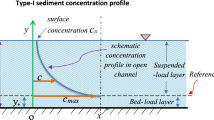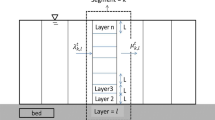Abstract
In this study the well-known Rouse equation and Barenblatt equation for suspension concentration distribution in a sediment-laden flow is derived using Shannon entropy. Considering dimensionless suspended sediment concentration as a random variable and using principle of maximum entropy, probability density function of suspension concentration is obtained. A new and general cumulative distribution function for the flow domain is proposed which can describe specific previous forms reported in the literature. The cumulative distribution function is tested with a variety sets of experimental data and also compared with previous models. The test results ensure the superiority of the new cumulative distribution function. Further a modified form of the cumulative distribution function is discussed and used to derive the suspension model of Greimann et al. The model parameters are expressed in terms of the Rouse number to show the effectiveness of this study using entropy based approach. Finally a non-linear equation in the Rouse number has been suggested to compute it from the experimental data.








Similar content being viewed by others
References
Barenblatt GN (1956) The suspended sediment movement in turbulent flow. Water Conservancy Press, Beijing
Chang FM, Simons DB, Richardson EV (1965) Total bedmaterial discharge in alluvial channels, Technical Report. USGS Water Supply Paper: 1498-I, U.S. Geological Survey
Cheng NS (2003) A diffusive model for evaluating thickness of bedload layer. Adv Water Resour 26:875–882
Chiu CL (1987) Entropy and probability concepts in hydraulics. J Hydraul Eng 113(5):583–600
Chiu CL (1989) Velocity distribution in open channel flow. J Hydraul Eng 115(5):576–594
Chiu CL, Tung NC (2002) Maximum velocity and regularities in open channel flow. J Hydraul Eng 128(4):390–398
Chiu C, Jin W, Chen Y (2000) Mathematical models for distribution of sediment concentration. J Hydraul Eng 126(1):16–23
Coleman NL (1986) Effects of suspended sediment on the open-channel velocity distribution. Water Resour Res 22(10):1377–1384
Cui H, Singh VP (2012) On the cumulative distribution function for entropy-based hydrologic modeling. Trans ASABE 55(2):429–438
Cui H, Singh VP (2014) Suspended sediment concentration in open channels using Tsallis entropy. J Hydrol Eng 19(5):966–977
Dey S (2012) Fluvial hydrodynamics: sediment transport and scour phenomena, vol 3. Springer, Berlin, p 173
Einstein HA (1950) The bed load function for sediment transportation in open channels, Technical Bulletin 1026. Soil Conservation Service, USDA, Washington
Einstein HA, Chien NS (1955) Effects of heavy sediment concentration near the bed on velocity and sediment distribution. US Army Corps of Engineers, Missouri River Division, Report No 8
Greimann BP, Muste M, Holly FM (1999) Two-phase formulation of suspended sediment transport. J Hydraul Res 37(4):479–500
Jaynes E (1957a) Information theory and statistical mechanics: I. Phys Rev 106:620–930
Jaynes E (1957b) Information theory and statistical mechanics: II. Phys Rev 108:171–190
Kumbhakar M, Ghoshal K (2016a) One dimensional velocity distribution in open channels using Renyi entropy. Stoch Environ Res Risk Assess. doi:10.1007/s00477-016-1221-y
Kumbhakar M, Ghoshal K (2016b) Two dimensional velocity distribution in open channels using Renyi entropy. Phys A 450:546–559
Kumbhakar M, Ghoshal K, Singh VP (2016) Derivation of rouse equation for sediment concentration using shannon entropy. Phys A: Stat Mech Appl 465:494–499. doi:10.1016/j.physa.2016.08.068
Kumbhakar M, Kundu S, Ghoshal K, Singh VP (2018) Entropy-based modeling of velocity lag in sediment-laden open channel turbulent flow. Entropy. doi:10.3390/e18090318
Kundu S (2015) Theoretical study on velocity and suspension concentration in turbulent flow, Ph.D. thesis. Indian Institute of Technology Kharagpur, West Bengal
Kundu S (2017) Prediction of velocity-dip-position at the central section of open channels using entropy theory. J Appl Fluid Mech 10(1):221–229
Laursen EM (1982) A concentration distribution formula from the revised theory of prandtl mixing length. In: Proceedings of the 1st international symposium on river sedimentation, vol 1. Guanghua press, Beijing, pp 237–244
Luo H, Singh VP (2011) Entropy theory for two-dimensional velocity distribution. J Hydrol Eng 16(4):303–315
Mazumder BS, Ghoshal K (2006) Velocity and concentration profiles in uniform sediment-laden flow. Appl Math Model 30:164–176
Ni JR, Wang GQ (1991) Vertical sediment distribution. J Hydraul Eng 117(9):1184–1194
Rouse H (1937) Modern concepts of the mechanics of turbulence. Trans ASCE 102:463–543
Shannon CE (1948) The mathematical theory of communications, I and II. Bell Syst Tech J 27:379–423
Singh VP (1996) Kinematic wave modeling in water resources: environmental hydrology, vol 198. Wiley, New York
Singh VP (1997) The use of entropy in hydrology and water resources. Hydrol Process 11:587–626
Singh VP (2011a) Derivation of the Singh–Yu infiltration equation using entropy theory. J Hydrol Eng 16:187–191
Singh VP (2011b) Hydrologic synthesis using entropy theory: review. J Hydrol Eng 16(5):421–433
Singh VP, Luo H (2011) Entropy theory for distribution of one-dimensional velocity in open channels. J Hydrol Eng 16(9):725–735
Singh VP, Rajagopal AK (1987) A new method of parameter estimation for hydrologic frequency analysis. Hydrol Sci Technol 2(3):33–40
Tanaka S, Sugimoto S (1958) On the distribution of suspended sediment in experimental flume flow, vol 5. Memoirs of the Faculty of Engineering, Kobe Univ, Kobe, pp 61–71
Tsallis C (1988) Possible generalization of Boltzmann–Gibbs statistics. J Stat Phys 52(1–2):479–487
Vanoni VA (1940) Experiments on the transportation of suspended sediment by water, Ph.D. thesis. California Institute of Technology, Pasadina
Wang X, Qian N (1989) Turbulence characteristics of sediment-laden flows. J Hydraul Eng 115(6):781–799
Zhiyao S, Tingting W, Fumin X, Ruijie L (2008) A simple formula for predicting settling velocity of sediment particles. Water Sci Eng 1(1):37–43
Acknowledgements
The author would like to thank the Associate Editor and the Referees for their helpful and constructive comments which improves the manuscript a lot.
Author information
Authors and Affiliations
Corresponding author
Appendix
Appendix
Let if \(c_i\) are some values of the suspension concentration with corresponding weight \(f(c_i)\) where f denotes the probability density function and \(f(c_i )\) denotes the probability of the observation \(c_i\) for \(i=1,2,\ldots ,n\). Then the weighted geometric mean is calculated as
It can be written as
This equation shows that \(\ln c\) is the weighted arithmetic mean of \(\ln c_i\) values. Therefore we can denote and write it as
Now taking the limit as \(n\rightarrow \infty \) and using
we have
Rights and permissions
About this article
Cite this article
Kundu, S. Derivation of different suspension equations in sediment-laden flow from Shannon entropy. Stoch Environ Res Risk Assess 32, 563–576 (2018). https://doi.org/10.1007/s00477-017-1455-3
Published:
Issue Date:
DOI: https://doi.org/10.1007/s00477-017-1455-3




